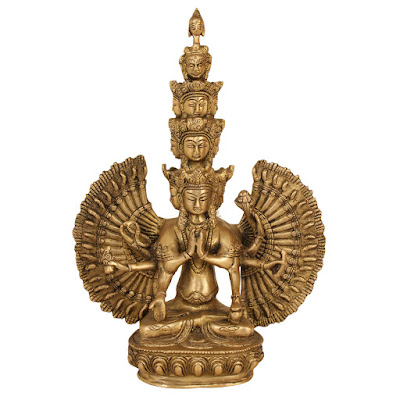Tibetan Buddhist Deity Eleven Headed Avalokiteshvara - Brass Statue
Here you will get products based Indian Art. You will
Sculptures and Statues based on Hindu God and Goddess, Nepalese God and Goddess,
Buddhist, Bodhisattva,
Rituals, South Indian Sculptures, Corporate Gifts, Dolls, Tantras, and much
more. You will get all these Statues and Sculptures in many different ways made
of Wood, Stones, Marbles, Brass Sculptures,
Bronze, Copper, Iron, Gold, Silver and much more.
The bodhisattva of compassion, Avalokitesvara (Chenrezi to
Tibetans) is portrayed here in his most powerful, royal form, with eleven
faces, one thousand eyes, and one thousand arms. He is saluted in a common
Tibetan prayer as "The holy Avalokiteshvara, who has the thousand arms of
the thousand universal monarchs, the thousand eyes of the thousand Buddhas of
this good eon, and who manifests whatsoever is appropriate to tame
whatsoever!"
There are several versions of the legend explaining his
eleven heads, but they all resolve themselves into the following:
Avalokiteshvara, the all pitying one, descended into hell,
converted the wicked, liberated them, and conducted them to Sukhavati, the
paradise of his spiritual father, Amitabha.
 |
| Tibetan Buddhist Deity Avalokiteshvara |
He discovered, however, to his dismay, that for every
culprit converted and liberated, another instantly took his place. Legend
claims that his head split into ten pieces from grief and despair on
discovering the extent of wickedness in the world, and the utter hopelessness
of saving all mankind. Amitabha caused each piece to become a head, and placed
the heads on the body of his spiritual son, Avalokitesvara.
Nine of the heads have benign faces and are depicted in three rows; the tenth
has an angry face, while the head at the top is that of Amitabha.
All the heads, except that of Amitabha, is crowned. In
contrast to the floral crowns of the three rows of heads, the top wrathful head
is adorned with a crown of skulls.
At a symbolic level, eight of the heads represent the
cardinal directions and their intermediate points, and the other three signify
the zenith, the center, and the nadir.
Fascinating as this myth is, it probably disguises an
earlier myth of cosmic creation in which a primal being created the universe by
disintegrating his own person.
Amitabha further said to Avalokiteshvara that there was
still another way to accomplish his goal. Mahakala, the wrathful aspect of
Avalokitesvara, was then created to fight against negative forces with
compassion and to destroy obstacles in the path towards righteousness, thereby
helping all sentient beings reach enlightenment. The tenth wrathful head is
thus that of Mahakala.
In addition, Avalokiteshvara is given a thousand arms which
form a mandala around his body and symbolize his pervasiveness. The palm of
each hand is marked with an eye, the 'eye of mercy', to see the sufferings of
all beings, and to help sentient beings overcome them.
The two central arms hold a wish-fulfilling gem; one main
right arm is holding the wheel of combined spiritual teaching and benevolent
governance; another upraised right hand holds the rosary. a left hand holds a
bow and arrow, their pairing symbolizes the coincidence of wisdom and method,
or the union of wisdom and concentration. Another upraised left hand holds a
lotus in full bloom. This is a symbol of purity, renunciation, and divinity.
Post Your Ad Here

Comments